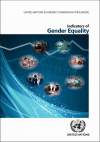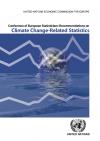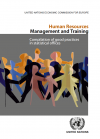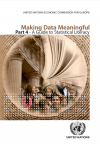Publications
Displaying Results 61 - 80 of 229
- Pусский
Статистический регистр предприятий играет центральную роль в производстве экономической статистики, как с точки зрения способа производства статистики, так и с точки зрения ее содержания и качества. Для оказания помощи странам Руководство по статистическому регистру предприятий содержит практические руководства и рекомендации по созданию и поддержанию статистического регистра предприятий.
- English
The statistical business register plays a central role in the production of economic statistics. Both in terms of the way the statistics are produced and in terms of the content and quality of the statistics. To assist countries the Guidelines on Statistical Business Registers provides practical guidance and recommendations on the establishment and maintenance of statistical business registers
- English
The increased movement of people across international borders has brought the issue of migrant integration to the forefront of national polices. International migration can have great societal and economic impacts, both positive and negative, on both individuals and countries of origin and destination, particularly when viewed through the lens of time. Thus, improved measurement of
- English
UNECE Countries in Figures presents a profile of social and economic indicators for each of the 56 UNECE member countries.These profiles, prepared by the UNECE Statistical Division, are intended to be of interest to readers not necessarily familiar with statistical terminology or with interpreting statistical tables. A glossary of terms and list of references is available at the back of the
- English
Statistics and indicators that reflect the realities of the lives of women and men are needed to describe women’s and men’s role in the society, economy and family, to formulate and monitor policies and plans, monitor changes, and inform the public. In 2010, the Conference of European Statisticians (CES) established the Task Force on Indicators of Gender Equality, to improve the monitoring of
- English
These first ever Recommendations on Climate Change-Related Statistics are aimed at improving existing official statistics to support climate change analysis and reporting on greenhouse gas emissions under the Kyoto Protocol. The focus is not on scientific or meteorological data describing changes in weather and climate, but rather on statistics that are relevant for analysing climate change,
- English
The last two decades have seen a proliferation of methods and indicators to measure sustainable development. Many countries and organizations have adopted sustainable development indicator sets to track progress towards a sustainable society. However, the differences between the approaches remain large. Therefore, the Conference of European Statisticians set up in 2009 a joint UNECE/Eurostat/
- English
The objectives of these Guidelines are to (a) help statisticians and policymakers understand the importance of time-use surveys, (b) provide guidance in the design and implementation of time-use surveys, and (c) improve the international comparability of their results. The Guidelines include recommendations of preferred or best practice, based on the experience of member countries
- English
Metadata are data that define or describe other data. Metadata are essential for interpreting data and making meaningful comparisons over time and between countries. This is particularly so for reporting on Millennium Development Goal (MDG) indicators, which often have multiple data sources and typically attract a wide audience of users who may have limited background in
- English
This publication reviews the practices followed by countries in the UNECE region (covering Europe, Central Asia and North America) during the 2010 round of population and housing censuses. The aim is to compare the different approaches and practices adopted by the countries and to assess the compliance with the Conference of European Statisticians (CES) Recommendations developed for
- English
This publication includes 24 papers highlighting good practices in human resources management and training in statistical offices. The papers cover a range of issues from recruitment and retaining of qualified staff and setting up training programmes, to competence mapping and management development. These papers have been presented at seminars and workshops on human resources management
- English
UNECE Countries in Figures presents a profile of social and economic indicators for each of the 56 UNECE member countries. It also includes information about certain territories of UNECE member countries for which separate data are available.These profiles, prepared by the UNECE Statistical Division, are intended to be of interest to readers not necessarily familiar with statistical
- English
This document contains a set of questions on health state, to enable the production of internationally comparable measurements for this topic. It reflects the work of the Budapest Initiative Task Force, composed of experts from many countries and international organizations. The Budapest Initiative recommends the inclusion of these questions in health interview surveys, organised at the
- English
Globalization is a growing phenomenon that affects the compilation of familiar national accounts indicators and related source statistics. This Guide for the first time provides comprehensive guidance for both producers of economic statistics and those who use the data for policy analysis and research. The aim is to give practical help to readers. The Guide accordingly reviews the many ways in
- English
The 2006 High-level Dialogue on International Migration and Development at the United Nations General Assembly concluded that international migration could play an important role in national development, provided that it was supported by the right set of strategies and policies. This has led to the increase in international efforts related to migration and its measurement. Responding to the
- English
In recent decades, families, households and living arrangements have gone through major changes in Europe and North America. In particular, the patterns of family formation, dissolution and reconstitution have become more heterogeneous and family boundaries more ambiguous.This publication presents a framework and a set of concepts and indicators for the measurement of new forms of families,
- English
This second edition of the handbook, prepared under the auspices of the Bureau of the Conference of European Statisticians, updates the original edition published in 2001. It reflects new international standards for household income statistics and provides further guidance on conceptual and practical issues related to their production and use. This updated handbook will be a key reference both
- Pусский
Данное Практическое пособие является результатом мероприятий, проведенных ЕЭК ООН, по укреплению потенциала в области экономической статистики в странах Восточной Европы, Кавказа и Центральной Азии. В Пособии рассматривается общий процесс выполнения сезонной корректировки, а также объясняются сопутствующие понятия. Пособие сводит воедино международные рекомендации по созданию временных рядов
- English
This practical guide is the result of UNECE capacity‐building activities in economic statistics for the countries of Eastern Europe, Caucasus and Central Asia. It suggests an overall process for performing seasonal adjustment and explains the related concepts. It brings together international recommendations for producing high quality time series, performing seasonal adjustment and
















